By Robert Draper
In Kamala Harris’ acceptance speech at the Democratic National Convention this past summer in Chicago, she sought to cast herself in thoroughly relatable terms. “The middle class is where I come from,” she said, using “middle class” eight more times as if trying to weave herself into the centre of an American electorate that has yet to understand her.
The candidate’s self-description was factually accurate, but what it left out was far more revealing. From interviews with roughly 100 people currently or formerly associated with Harris, understanding the Democratic nominee for president requires breaking down her phrase “where I come from” into three parts.
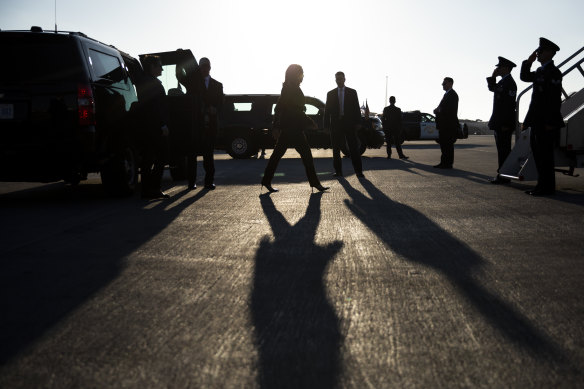
Vice President Kamala Harris boards Air Force Two at Los Angeles International Airport. Credit: Jenna Schoenefeld/The New York Times
First, she is the tenacious eldest child of supremely motivated, risk-taking immigrants: a mother who came from India with the ambition of curing breast cancer and a Jamaican father who set his sights on shaping his country’s modern economy.
Second, she is the offspring of scientists whose devotion to reason and methodology would guide her in her first career as a law-and-order, linear-minded prosecutor rather than an ideologue. “Fix it,” she would say. Or, “Let’s move on.”
Third, she is the daughter of an Asian woman and a black man – a human Venn diagram “living in the intersections as a woman of colour”, said her friend, Mini Timmaraju, president and chief executive of Reproductive Freedom for All. From Harris’ childhood in the Berkeley flatlands of California to her current position in the White House, she has lived with the awareness that her gender and racial background have made the world prone to prejudging her.
‘As a black woman of multiple backgrounds, she’s in some ways a unicorn in American politics.’
Chuck Collins, attorney and long-time San Francisco Museum of Modern Art board member
“It’s not a new thing for her, being disrespected for reasons that have nothing to do with her actual capabilities,” said Jill Louis, a lawyer and friend of Harris since the two were sorority sisters at Howard University. “Does she talk about it? No. Because she’s not a whiner.”
Still, said Louis of her friend: “You learn to put those shields up early.”
That armour has confounded even those who have known her for decades. One of them, former San Francisco mayor Willie Brown, once Harris’ political mentor and boyfriend, reflected on her in a recent interview. “She’s still a mystery,” he said. “Still a mystery. And she’s going to keep it that way.”
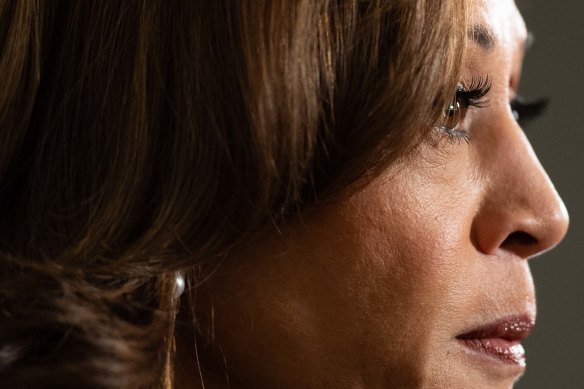
Vice President Kamala Harris has emphasised her middle-class roots. She dwells less on her experiences as a woman of colour.Credit: Ruth Fremson/The New York Times
A succession of risks
From certain angles, Harris lives the life of a perfectly normal American woman.
She works out in the morning as penance for her sweet tooth. She dances to hip-hop and R&B, as she once did to Aretha Franklin’s Rock Steady in the living room of her childhood home in Berkeley. She has a piercing, attenuated laugh that amuses her friends, even though one of them likes to ask her in mock exasperation, “are you done yet?”
She is married to a man she calls Dougie, who is fond of the band Rage Against the Machine. She goes to a Baptist church and has been known not to take calls when the San Francisco 49ers are playing. She is superstitious: when she ran for district attorney and attorney general in California, she always ate on Election Day at Delancey Street Restaurant, a San Francisco institution.
She can be emotionally inaccessible to some, particularly members of the media, while warming immediately to those who are vulnerable or grief-stricken. She is a spur-of-the-moment visitor at hospitals where friends or their loved ones lie dying. She gravitates towards the children of others, taking them aside to inquire about their schoolwork and favourite teachers.
So yes, she is normal. But ordinary, no.
What Harris characterised in her acceptance speech as her “unexpected” journey to the precipice of the Oval Office becomes somewhat less so when considering her origins.
Her father, Donald, a product of Jamaica’s entrepreneurial class, immigrated to the United States in 1961 at the age of 22 to study economics at the University of California at Berkeley. Sixty years later, after becoming Stanford University’s first black professor of economics to achieve tenure, his role in the development of Jamaica’s postcolonial economy would earn him that country’s Order of Merit, a distinction that only 15 living individuals can possess.
After her parents separated when she was five, Harris fixated on a single role model: her mother. Shyamala Gopalan Harris hailed from upper-crust Tamil Brahmin stock in what is now known as Chennai, India, and took her own journey to California at the age of 19 to become a biomedical scientist.
She would go on to receive grants from the National Institutes of Health for her pioneering work in the field of breast cancer research before dying of cancer herself in 2009.
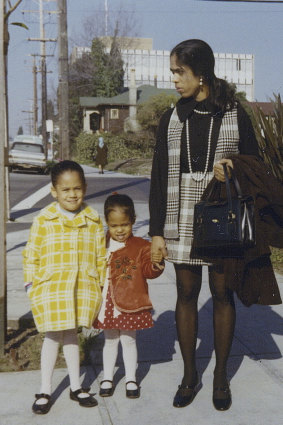
This January 1970 photo shows Kamala, left, with her sister, Maya, and mother, Shyamala, outside their apartment in Berkeley, California, after her parents’ separation. Credit: AP
In November 2021, while attending the Paris Peace Forum as vice president, Harris visited the Institut Pasteur, where she met a scientist who had collaborated with her mother on estrogen research four decades earlier.
Harris is, in sum, a child of high achievers, raised in a household frequented by intellectuals and civil rights activists. Huey P Newton, founder of the Black Panther Party, was a familiar presence in her neighbourhood. At the black cultural centre where her mother took Harris and her younger sister most Thursday evenings, legendary figures such as James Baldwin, Nina Simone and Shirley Chisholm took the stage.
By the time she was 12, Harris had already visited Jamaica, India and Zambia and was attending school in Montreal after her mother took a job at McGill University there. As difficult as such a transition would have been for any child, much less a girl of colour thrust into an overwhelmingly white student body, she came out of it with passable French and a determination to “return home for college”, as she later wrote.
“Home” turned out to be the prestigious historically black university, Howard, the Washington, DC-based alma mater of one of her childhood heroes, Supreme Court Justice Thurgood Marshall.
At Howard, where she carried a briefcase to class and was on the school debate team, she struck her classmates as a preternaturally worldly young woman determined to forge her own path. “She always had her own style and was never a follower,” said Stacey Johnson Batiste, a friend since kindergarten. “She’s been wearing pearls as long as I can remember.”
At what is today known as UC Law San Francisco, she was not a gifted student in the way her parents were and was not viewed as “most likely to succeed”, a distinction that fell to her classmate, J Christopher Stevens, a future US ambassador who was killed by militants in Benghazi, Libya. But she became president of the school’s Black Law Students Association and organised a jobs fair on campus for herself and her fellow seniors.
Straight out of law school in 1989, Harris became one of a handful of applicants to join the district attorney’s office of Alameda County, an esteemed Oakland group of prosecutors with a storied history: Earl Warren, who, as chief justice of the Supreme Court would later write the majority opinion in Brown v Board of Education establishing racial segregation in public schools as unconstitutional, became the county’s district attorney in 1925.
As a line prosecutor, Harris handled some of the office’s toughest cases, many of them involving sexual assault or child abuse. “She had very strong skills in the courtroom,” said a former supervisor of Harris’, Nancy O’Malley, who later became the county’s district attorney. “But what drew me to recruit her for sex crimes cases was how she could sit in the hallway next to a victim and show them such compassion that she’d win their trust and have the courage to take the witness stand.”
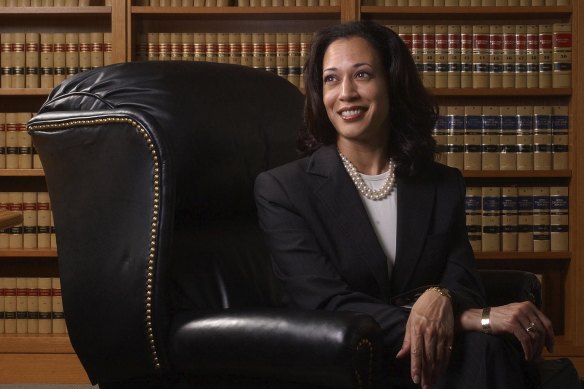
Harris was elected attorney-general of California in 2010, becoming the state’s first woman and first person of colour to hold the position. Credit: nna\sswain
O’Malley could also see that her young prosecutor “was obviously very ambitious” as she began to move into San Francisco society and politics. In March 1994, San Francisco Chronicle columnist Herb Caen noted in print that the California state assembly speaker, Willie Brown, had celebrated his 60th birthday in the company of Clint Eastwood, Barbra Streisand and “the speaker’s new steady, Kamala Harris, an Alameda County deputy DA [district attorney] who is something new in Willie’s love life”.
Brown went on to appoint Harris to the Unemployment Insurance Appeals Board (with an annual salary of $US97,088) and then, six months after she resigned, to the California Medical Assistance Commission (which paid $US72,000 annually). A year later, Harris accompanied Brown – who was 31 years older than her and married but long estranged from his wife – to the wedding of Nancy Corinne Pelosi, the eldest daughter of the San Francisco congresswoman and future House speaker.
“No question, Willie opened doors for Kamala,” said Art Torres, chair of the state’s Democratic Party from 1996 to 2009. “But as soon as she walked through them, you couldn’t help but notice her and say ‘who is this future star?’”
Although the two broke up just after Brown won election as mayor of San Francisco in December 1995, Harris had by then cemented friendships with many of the city’s high-profile Democratic donors, including Vanessa Getty and Susan Swig. She was also given a seat on the board of the San Francisco Museum of Modern Art. “We wanted to grab her before one of the city’s other cultural institutions did,” said Chuck Collins, an attorney and longtime museum board member.
In 1998, Harris said goodbye to the East Bay, relocated to San Francisco and joined its district attorney’s office. The DA, Terence Hallinan, belonged to one of the city’s dominant political families, along with the Pelosis and the Feinsteins. But Harris was among Hallinan’s deputies who found his management style to be chaotic. She resigned in 2000 and moved to the city attorney’s office. Three years later, she ran against him and won.
Her long-shot victory against Hallinan amounted to the first in what would be a series of career risks. The second one came four years later when Harris became the first prominent elected Democrat in California to endorse the presidential candidacy of Barack Obama, whom she had met at a fundraiser in San Francisco during his 2004 run for the Senate.
The two ascendant black Democrats developed a natural kinship, although Harris fretted over her political bet to break from a party apparatus that had sworn its allegiance to Hillary Clinton. In the end, said Brian Brokaw, who later became her political consultant, “it was a defining moment in her career”.
Obama’s victory in 2008 all but guaranteed Harris a job in the administration’s Justice Department. Instead, she elected to run for state attorney-general, a post that had never been occupied by either a woman or a person of colour.
Her 2010 upset victory by less than a point over Steve Cooley, the Republican district attorney of Los Angeles County, featured elements that foreshadowed her current candidacy: She took on Cooley’s claim that she was a “radical” by vowing to represent “all the people of California”, and turned in a convincing debate performance aided by her opponent’s unforced errors. Her electoral outcome also took four weeks to confirm.
Nonetheless, the race established Harris as a national star. “I was so in awe of the gamble she took, running as a woman of colour to be the state’s lead prosecutor,” said Barbara Boxer, at the time a US senator from California. “In those days, political machines wouldn’t take a risk on a woman. She had to build her own machine.”
As San Francisco district attorney, Harris unleashed a flurry of new initiatives, some more successful than others. In similar fashion, the new state attorney-general made the most of her elevated profile, taking on some risky initiatives.
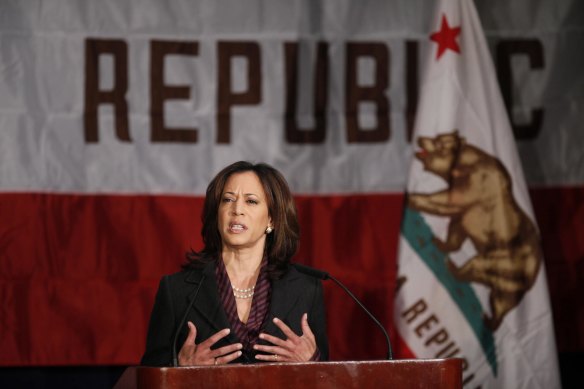
Kamala Harris gives her first news conference in Los Angeles as California attorney general on November 30, 2010. Credit: AP
She led partnerships with other states and Mexico to attack transnational gangs. Twice, she went toe to toe with the Obama administration: first, in the wake of the subprime mortgage crisis, she pushed for a more advantageous settlement with the banks than Justice Department officials had brokered. Later, in the case of Corinthian Colleges, she demanded that the for-profit institution pay back the students it had swindled when the Education Department preferred to see Corinthian’s debts forgiven. In both cases, Harris prevailed.
Four years into Harris’ tenure, Boxer announced that she would not seek another term in the Senate. Harris declared her candidacy a few days later and proceeded to swamp the field. After her victory in November 2016, Boxer congratulated her successor, saying: “This is the dream job of a lifetime.”
It therefore surprised Boxer when, only two years into the job, Harris declared that she was running for president. In daring to fail – which Harris ultimately did, suspending her presidential campaign in December 2019, six weeks before the first primary votes were cast – the candidate displayed something that Boxer would later describe as awe-inspiring.
“It was her unflappability,” she said. “She always saw herself this way, as presidential material.”
A prosecutor’s view
Harris’ 2019 campaign revealed a person for whom, despite her previous four electoral victories, politics did not come naturally. She struggled to define herself ideologically. She could not convince Democratic donors that she was more electable than the two top candidates in the field, Joe Biden and Senator Bernie Sanders.
And, said Brown, her political mentor: “What she hasn’t ultimately mastered is how to become the most interesting candidate to the media.”
Those who have known Harris from her earlier days in California say that unlike the state’s governor, Gavin Newsom, she is not a political junkie. Those who have worked with her as vice president also point out the distinctions between herself and her boss, Biden.
She is culturally to the left of him, having grown up among the San Francisco Bay Area’s LGBTQ+ community, and her reflexive support for women’s reproductive freedom is uncomplicated by the traditional Catholic beliefs that Biden holds. At the same time, she lacks his reverence for New Deal-style big government.
Biden, his aides say, sees the world in two opposing political camps: democracies and autocracies. The vice president sees the world as bifurcated, with those who obey the rules on one side and those who break them on the other.
The most common descriptor of Harris by those who have worked with her is “prosecutor”.
Harris often speaks to audiences as she once did to juries, making her case through the stark marshalling of facts. She prizes linearity and scorns what she terms “fancy speeches”. Her speechwriters are instructed to strip away purple prose in favour of declarative sentences.
Fittingly for a career prosecutor, the modifier most used by subordinates to describe Harris is “prepared”. Early in her political career, when meeting an influential person, she would direct staffers to collect that person’s business card, retain it in a book and later find a pretext for following up with him or her.
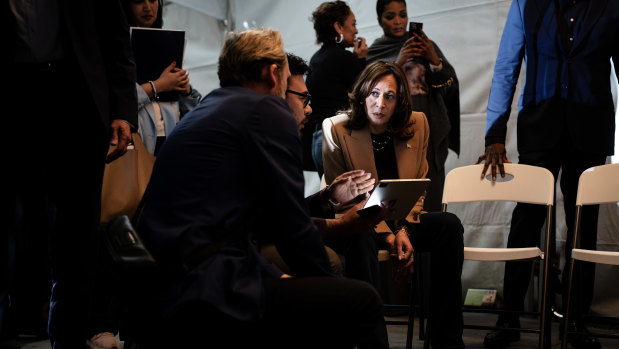
Harris speaking with her staff backstage at a campaign event in Clarkson, Georgia, last week. She still thinks like a prosecutor, many who have worked with her say.Credit: Erin Schaff/The New York Times
Before making up her mind on a policy, she will often deputise an aide to argue the opposite side of the issue. The policy binders assembled for her by past and current aides are throwbacks to the ones she carried into a courtroom: assiduously organised, written in direct language and detailed to a fault. Several staffers interviewed for this article spoke, half-joking, of their dread of Harris’ later handing back the briefing books ravaged by her copious marginalia.
On Capitol Hill, senator Harris’ preparedness was evident in her grilling of witnesses. A Democratic colleague of hers on the Senate Select Committee on Intelligence, Senator Martin Heinrich of New Mexico, recalled: “As a brand-new senator, she sat at the very end of the dais. Usually, by the time it’s the new senator’s turn, all the good questions would have already been asked. But she was always light on her feet, thought fast and managed to get important information.”
During the nationally televised Supreme Court confirmation hearings in 2018 of Brett Kavanaugh before the Judiciary Committee, Harris was the 20th of 21 members to question him. Still, she managed to stump the nominee with one of the hearing’s most memorable lines of inquiry: “Can you think of any laws that give government the power to make decisions about the male body?”
“In some ways, she was ahead of her time with that question,” said Senator Amy Klobuchar, a more senior Democratic colleague on the judiciary committee. “She was calling attention to where these guys were on these issues.”
An unfamiliar role
After 17 years as a district attorney, state attorney general and US senator, Harris became vice president and was no longer her own boss.
She was not free to set an agenda, start pilot programs or even hire a staff of her own choosing.
Biden had, in fact, given her the same level of influence that he had as vice president in the Obama administration: she would be able to participate across the entire spectrum of White House policymaking, and she would be the last person to talk to the president before a major policy decision was reached. There was a major difference, however.
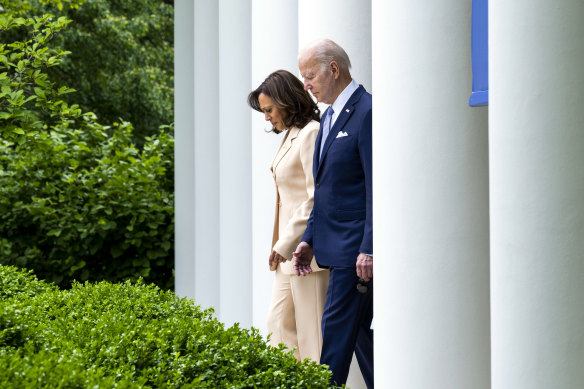
President Joe Biden gave Harris the same level of influence that he had as vice president in the Obama administration. Credit: Doug Mills/The New York Times
Unlike Biden’s vice presidency, in which he often briefed reporters off the record and in the process described his own impact on major issues, the influence of Harris was opaque at best. Given that she was serving a president who had spent nearly half his life on Capitol Hill, it was never clear what value she could add as a one-term senator.
The two assignments that she was publicly given by Biden – ensuring passage of voting rights legislation and addressing the root cause of migration from Latin American countries – stood little chance of being seen as successful and, in fact, were not. For the first time in her public life, Harris was viewed by many as unserious. Biden’s favorability ratings languished, but hers were even worse. “She was second fiddle, by the nature of the office,” said former senator Jeff Flake, Republican for Arizona, who had worked alongside Harris on the Judiciary Committee. “It’s extremely difficult to gain respect in that job, and she was doing the best she could with it.”
She gave few interviews and often struggled when she did.
When Lester Holt of NBC News asked her in June 2021 why she had not been to the border when she was working on immigration, she retorted: “And I haven’t been to Europe.” More than a dozen of her friends and political associates said they cringed at her defensiveness.
Many of her top aides were new not only to the White House but to the political warfare of Washington and lacked the leverage to go to bat for her in the West Wing. In Harris’ first 18 months in office, before she turned to more seasoned advisers, she had a high staff turnover and struggled to hold her own against the president’s tight inner circle of older men who had served him for decades.
But she seized whatever opportunities she could to make her mark on Biden administration policies, people close to her said.
An initiative she had championed as state attorney-general to lower diesel fumes, and which she brought to the Senate in the form of the 2019 Clean School Bus Act, ultimately became a $US5 billion ($7.6 billion) set aside for electric school buses in the Infrastructure Investment and Jobs Act of 2021. A bill she introduced in 2019 as a senator to replace lead pipes nationwide finally achieved funding through the American Rescue Plan Act of 2021 and the Inflation Reduction Act of 2022.
Biden’s team cast the president as the architect of those laws, as was to be expected. The same held true with the 2022 gun-safety law known as the Bipartisan Safer Communities Act, which was seen as a culmination of Biden’s decades-long effort to stem gun violence. Behind the scenes, however, Harris and her staff worked with the White House’s Office of Gun Violence Prevention to implement the law through a series of executive actions, including improving active-shooter drills at schools and requiring that all businesses principally engaged in the business of selling firearms undergo background checks.
Harris was not a big player in shaping the landmark economic legislation of Biden’s presidency, and it was his experienced foreign policy team that took the lead in the international response to Russia’s invasion of Ukraine. But she did focus on helping small businesses and families, particularly as an early champion of the childcare tax credit and in funnelling COVID-19 relief money to small businesses. In February 2022, she was dispatched to the Munich Security Conference, where she briefed Ukrainian President Volodymyr Zelensky on Russia’s hostile intentions. (Zelensky reacted sceptically to Harris’ warnings. Five days later, Russian troops invaded his country.)
The event that finally gave Harris a national platform was the June 2022 Supreme Court decision that overturned Roe v. Wade and eliminated the constitutional right to abortion. Still, she was initially leery when Biden’s chief of staff at the time, Ron Klain, urged her to become the administration’s leading voice on women’s reproductive rights. She did not want to be seen as a figurehead, she told Klain, especially if Biden, long uncomfortable discussing abortion in public, showed any equivocation in backing her efforts. Klain assured her that she would have the president’s full support.
Harris proceeded to convene dozens of meetings with activists, mayors and medical professionals across the country, often in states with highly restrictive abortion laws. At an event in Nevada, a local staffer at Planned Parenthood, Raquel Cruz-Juarez, made the observation that a person did not have to abandon their faith to recognise that the government should not be telling women what to do with their bodies.
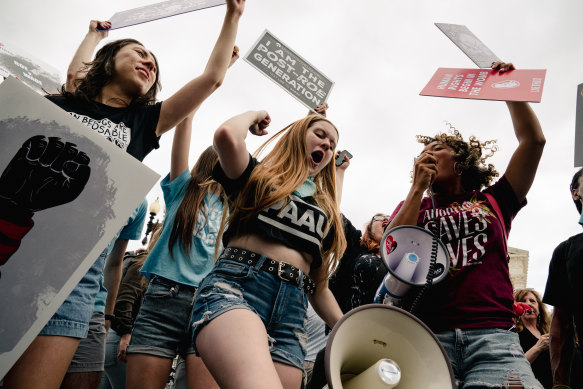
Anti-abortion activists celebrating the Supreme Court’s decision to overturn Roe v. Wade in Washington in 2022. In response, Ms. Harris became the administration’s leading voice on abortion rights. Credit: Shuran Huang/The New York Times
Turning to an aide, Harris said: “You need to write that down.”
Harris took Cruz-Juarez’s sentiment back to the White House, where Biden had been inclined to tout his economic accomplishments as the predominant message for the upcoming 2022 midterm elections. By November, the party had largely taken Harris’ view that abortion rights were the winning issue. The Democrats held on to the Senate and lost far fewer House seats than anticipated in the best midterm performance by a Democratic administration in modern history.
Four months ago, after Biden’s abysmal debate performance against Donald Trump, most party leaders turned against him. His vice president did not. “She was 100 per cent loyal to the president in saying it was his choice, and she stood completely behind him,” Klain said. “But once he made the decision, she moved forward in a way that showed her political prowess and the affection she had in the party. She became the consensus nominee because she deserved it.”
‘A unicorn’
Rarely has Harris discussed the barriers she and other women have faced, especially those of colour. Instead, she has emphasised how her mother, “a brown woman with an accent,” maintained her composure and “taught us to never complain about injustice, but do something about it.”
One of those injustices she mentioned was how her mother faced sexual discrimination at the University of California at Berkeley, where she worked as a scientist at the cancer research laboratory in the 1970s. Two childhood friends of Harris’ recalled that her mother relocated to McGill after her job at Berkeley was terminated because of a clash with a male colleague. (The Washington Post first reported on this incident.)
Several years later, Harris, by then a teenager, returned to the Bay Area during summer vacation and joined a few black friends who were driving to a party on Alameda Island. According to two friends to whom Harris later described the incident, their car was pulled over by local police officers. Although the officers did not issue any citations, Harris and her friends were instructed to turn around and depart the island immediately.
In college, her friend and sorority sister Louis later recalled, “She’d talk about what I’d call disparaging slurs for every aspect of her heritage”.
Upon entering politics in 2003, she faced two opponents in the race for district attorney, both white men, who would broadly hint that she owed her candidacy to Brown, despite the facts that the two had ended their relationship eight years earlier and that the mayor was neither an adviser nor a donor to her campaign.
Later still, Harris, the only woman of colour on the Senate Intelligence Committee, was cut off by her Republican colleagues while attempting to question witnesses during committee hearings, an unusual breach of protocol, twice in one week.
“As a black woman of multiple backgrounds, she’s in some ways a unicorn in American politics,” said Collins, the attorney who served with Harris on the board of San Francisco’s Museum of Modern Art. “And for all of us with diverse backgrounds, particularly from her generation or earlier, we’ve always had an unmitigated focus on excellence, knowing that in order to achieve it, we have to overperform.”
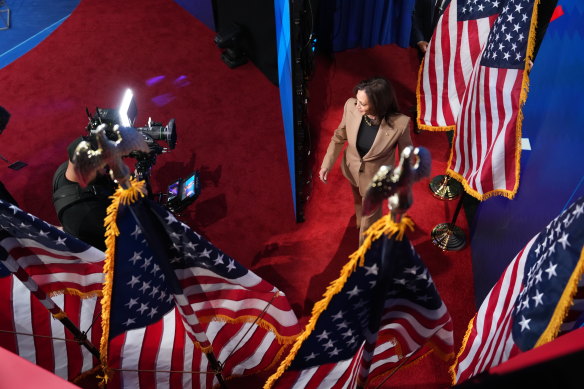
Harris has said that her mother “taught us to never complain about injustice, but do something about it”.Credit: Erin Schaff/The New York Times
One of Harris’ earliest efforts in the Senate was to address disparities in maternal health among black women, who suffer the highest rate of pregnancy-related deaths in the United States.
“The problem is no secret in our community, but it had never gotten serious attention in the federal government,” said Representative Lauren Underwood, a black Democrat from Illinois who teamed up with Harris and another black Democrat, Representative Alma Adams of North Carolina, to write the so-called Black Maternal Health Momnibus Act. “As the only black woman in the Senate, her voice was uniquely suited to tackle that issue.”
Noting that Harris carried a piece of the legislation with her into the White House, where it was signed into law in November 2021, Underwood said: “That doesn’t happen without her leadership.”
Harris has often used the vice president’s official residence at the Naval Observatory to stage events that signal her dedication to inclusiveness. In June 2023, she threw a pride event that included among the roughly 300 attendees Donna Sachet, a San Francisco activist and drag performer whom Harris knew from her days in the city.
In an interview, Sachet recalled being surprised and thrilled to have received her invitation but also somewhat nervous. She emailed the vice president’s social secretary and asked if she would be able to attend “in my persona”.
Yes, came the reply, along with the request that Sachet arrive a half-hour early so that she could be included in the VIP seating. She did so. The vice president spotted her, walked over and gave her a hug.
Looking around the residence in amazement, Sachet said: “I don’t even know how I got invited to this.”
“Because I put you on the list,” Harris replied.
The end of an unexpected journey
On the morning of July 21, Harris was making pancakes for her niece’s two daughters in the vice president’s residence when she received a call from Biden, who informed her that he would not be seeking a second term and was instead endorsing her to succeed him. The conversation was brief, and Harris knew what to do after it was over.
What ensued over the next 10 hours, with Harris sitting in her workout clothes in the living room of the vice president’s official residence while surrounded by eight aides with buzzing cellphones, was a demonstration of her methodical nature as she proceeded quickly to consolidate support within the party.
Her swift success was, in large part, a testament to Biden’s imprimatur. But it also was a validation of the unsung work she had done as his vice president. “I’d been on so many Zoom calls with her on so many issues,” said Klobuchar, who had already announced her support of the vice president by the time she received a call from her that afternoon. “She was doing important stuff behind the scenes.”
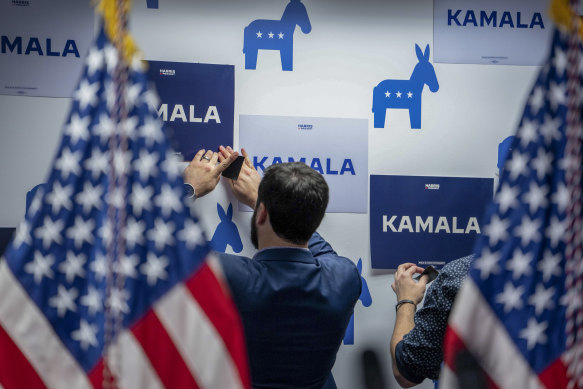
Campaign staff installing “Kamala” signs at the headquarters of the former Biden campaign office in Wilmington, Delaware, in July, after the president withdrew from the race.Credit: Erin Schaff/The New York Times
That groundswell of support, combined with her energetic public appearances after Biden’s endorsement, catapulted Harris to overnight sensation status as she waltzed unopposed into the Democratic National Convention. The journey that she described in her acceptance speech as “unexpected” would, over time, take on an aura of inevitability.
Nonetheless, it is a trajectory freighted with portent, of the sort that sometimes seems like the fruit of a Hollywood scriptwriter’s overly caffeinated imagination. A daughter of immigrants, reverential of law and order, determinedly stoic, finds herself pitted against a bombastic white male who has been accused and convicted of numerous criminal offences and whose political vocabulary is a soundtrack of grievance and bigoted insults.
The two have in common a desire for the presidency and nothing else.
If Trump loses, he is likely to claim otherwise, as he has ever since he was defeated four years ago. Harris, for her part, publicly acknowledged that she had no path to victory during her previous quest for the presidency when she suspended her campaign on December 3, 2019, before the Iowa caucuses.
Five days earlier, she and her husband hosted a Thanksgiving dinner at their rental house in Des Moines, where Harris had been spending much of the previous weeks campaigning. In addition to the Harris family, two other invited guests showed up: Klobuchar, who was then Harris’ rival for the 2020 Democratic presidential nomination, and her husband, John Bessler.
“She already knew what was upon her,” Klobuchar recalled.
But, she added, the subject of defeat did not come up. Instead, Harris made the dinner, served it, sat with her niece’s two small daughters in her lap, left the campaign at the end of the weekend and returned to her job in the Senate.
This article originally appeared in The New York Times.
Get a US election wrap-up every Tuesday, plus a Thursday note from our foreign correspondents on what’s making news around the world. Sign up for our What in the world newsletter.